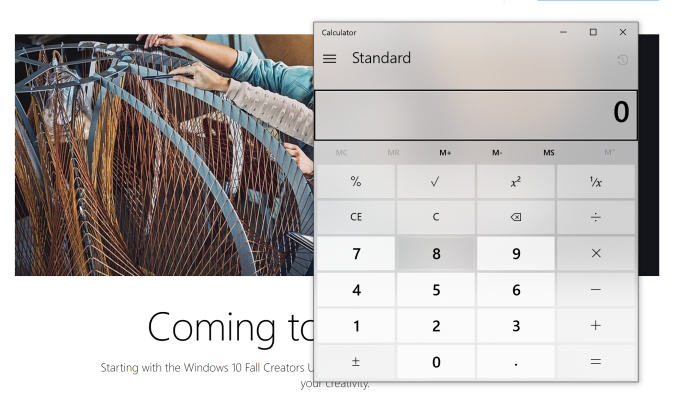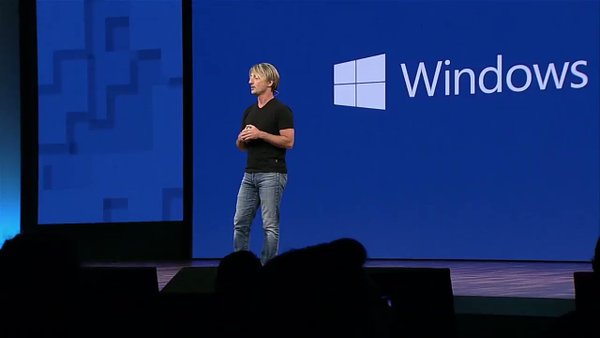The Windows 10 Fall Creators Update Feature Focus
by Brett Howse on November 10, 2017 8:00 AM ESTFluent Design
First announced at the Build 2017 developer’s conference, Fluent Design is the first major overhaul of the Windows 10 design and theme since Windows 10 washed away the remnants of Windows 8 back in 2015. Overall, the original design of Windows 10 has served it well, and it has been made clear after using it for the last several years that lessons were certainly learned from Windows 8, and those lessons were applied to Windows 10 to make a much more coherent and usable design language. But, as with anything, there’s always room for improvement, and the Redmond company is hoping that Fluent Design not only improves on the original, but keeps the UI and theming fresh.
Windows 10 runs on many different devices. The scalability of it is somewhat amazing, and after years of wanting to consolidate it’s OS efforts across device categories, it seems to have finally happened with Windows 10. But that brings some challenges as well, and as hardware has continued to evolve, we’ve started to see many different usage scenarios that traditional mouse and keyboard input would never work on. Touch, of course, is the most obvious and pervasive of these, and falls into the 2D category of input methods, along with keyboard and mouse, stylus, and more of the input methods we are used to. But we now live in a world with virtual reality, and augmented reality, both which live in the 3D space. There’s also 0D devices, such as the recently announced Cortana powered Harmon Kardon Invoke speaker and similar devices such as the Amazon Echo. IoT is becoming pervasive, and appears to be the next growth target in computing.
Fluent Design targets more than just 2D with five basic concepts: light, depth, motion, material, and scale. It may seems like a simple idea, but the key Fluent Design is that it will work well across different device types, but still be very useful on the traditional PC where Windows 10 still has its largest audience.
The move from Windows 7 to Windows 8 was pretty jarring, and the design language was very much flat and blocky. Windows 10 had already added some of the depth back in, but with Fluent Design they have also brought the essence of Windows 7 Aero back, along with new elements as well.
It’s tough to discuss Fluent Design without seeing it, because it’s not just a static idea. All of the elements tie in together to make the experience easier to navigate, more coherent, and more immersive. Check out this video that Microsoft created for their Dev Day:
Light is one of the key elements for selection, and this is doubly the case when you’re thinking of VR and AR technology, where a light gaze can be your pointer. Subtle highlights in lists give a stronger sense of where you are, and what you’re selecting.
Depth plays a big part too, and in the video you can see how going forward and backward in apps gives the feeling of going into an app or image, and then back out, connecting the experience of movement with where you are. This also plays into the motion, where you’ll see parallax scrolling and more.
Material selection is the transparency effects that will likely remind most people of Aero, but it is much more than just blurring. Instead of just background colors and blur, they will be doing multiple layers with Gaussian blur, exclusion blend, color and tint overlays, and tiled noise texture. The acrylic material can bring additional layering and depth to the app as well, but material is also able to be tied into scale, where if an app is in a windowed mode, it can have some blurring, but in a full-screen view, the blurring is eliminated to create focus on the one app.
Scale is likely the most underrated of them all, but Windows 10 is designed to work on everything from IoT to PC to Xbox to Surface Hub, so scale is critical to creating an app which will work across all of those form factors.
It’s hard to deny that Fluent Design is both form and function. There are design elements that are going to improve usability, but those same design elements also just look great. As we move forward, hopefully we’ll start to see more and more of this appear inside of Windows 10 and in the apps we use.
That’s really the only downside to Fluent Design right now though. There’s some of it sprinkled inside of Windows 10, and there’s work to be done to bring it more prominently to the forefront. The Action Center, for instance, has some elements of Fluent Design, but hovering over one of the notifications doesn’t bring any lighting effects to let you know you’re able to select it. Only some of the built-in apps have support right now. This will come over time, and likely even more slowly for third party apps, but it’s not here yet, at least not to its full extent.














95 Comments
View All Comments
ddrіver - Sunday, November 12, 2017 - link
Oh, and don't get me started on the whole "other big OS makers collect everything about you at all times" or "other big OS makers don't bother to push hardware vendors to support phone hardware more than 2-3 years so you only get 1 or 2 years of major updates". M$ is the real problem here.BurntMyBacon - Wednesday, November 15, 2017 - link
@ddriver: "Oh, and don't get me started on the whole "other big OS makers collect everything about you at all times" or "other big OS makers don't bother to push hardware vendors to support phone hardware more than 2-3 years so you only get 1 or 2 years of major updates"."You want me to brush aside grievances from other vendors to make Microsoft look worse by lack of comparison? I REFUSE!!! Phones and tablets may be consumption devices that you are better off leaving anything sensitive far away from, but they've been pushed as computer replacements, they've been developed for as computer replacements, and much of the market uses them as computer replacements. People email on their phones, send sensitive messages on their phones, use their phones to facilitate payments, and even bank on their phones. You can either call out people for doing things the are not educated enough to know they shouldn't do on their phones, or you can call out the vendors for creating and environment designed to cater to these practices while siphoning data in the background. Not everyone can be a security expert and the average consumer has a difficult enough time with malicious entities sending bad emails, texts, and links through their messenger/social app of choice. They shouldn't have to consider companies like Google, Microsoft, and Apple as malicious entities.
@ddriver: "M$ is the real problem here."
No. If Microsoft fixed everything, it would not affect the issues you stated above with other vendors. Microsoft's actions are problematic for sure and they should not be excused just because vendor X, Y, and Z are worse. However, Microsoft's actions are a symptom of a larger problem created by the anti-privacy features built into iOS and Android devices when smartphones were rising in popularity and perpetuated by the lack of concern over these privacy invading features by the worldwide market. If enough people wholesale dropped these platforms (read: Significant loss of profits) for a less invasive platform despite the extra costs and inconveniences involved, then they would fix some of these problems. Unfortunately, not enough people seem to care.
cwolf78 - Friday, November 10, 2017 - link
Funny how there are a ton of comparison benchmarks including on this very site that completely refute your anecdotal claims.Mo3tasm - Friday, November 10, 2017 - link
You can benchmark how you want, but the "perceived" difference can't be benchmarked.mr_tawan - Saturday, November 11, 2017 - link
perception sometime is truth, some other time is illusion."Bullwinkle J Moose" - Friday, November 10, 2017 - link
"slower than Win7 or even Win8.1"----------------------------------------------
That depends.....
Bootup and shutdown speed is markedly faster but doing anything with your data is markedly slower
"Bullwinkle J Moose" - Friday, November 10, 2017 - link
I just again tested Windows 8.1 boot time at 14 seconds (that is normal)Win 10 Full Crapper Edition booted to the same PC with the same SSD in 5.3 seconds
ddriver - Friday, November 10, 2017 - link
Who cares about boot up speed, I boot up once every few months. Even a regular user doesn't boot up nowhere nearly enough to make a difference, when it craps over your entire usage."Bullwinkle J Moose" - Friday, November 10, 2017 - link
Regular users, sure, but I measure it and care because I have been known to boot several different operating systems from this machine in a single dayBIOS is set so that there is no primary boot device, which means that I can swap drives (or thumb drives) while the computer is rebooting and it will boot to whatever is currently plugged in instead of fumbling in the BIOS to change the boot order
Makes testing something new quick and easy, whether its in XP, Linux, Win 7, Win 8 or any Edition of Spyware Platform 10
"Bullwinkle J Moose" - Friday, November 10, 2017 - link
I also keep all the bootable SSD's on an external SATA to ESATA+USB Power cable so when I switch from SSD to thumb drive during a reboot, all I need to do is unplug the USB power to the SSD boot drive and plug in a thumb drive during reboot